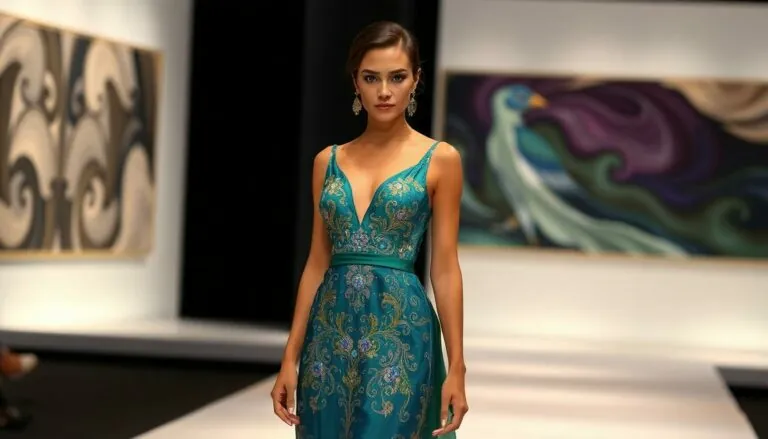In a world where fashion can sometimes feel like a high-stakes game of hide and seek, ready-to-wear fashion swoops in like a superhero in a stylish cape. Forget the hours spent agonizing over custom fittings and the anxiety of runway-inspired looks that only exist in dreams. Ready-to-wear offers a delightful blend of style and convenience, making it easier than ever to look fabulous without breaking a sweat.
Imagine slipping into an outfit that feels as good as it looks, all while knowing you’re rocking the latest trends. Ready-to-wear fashion gives everyone a chance to shine, whether they’re strutting down the street or lounging at home. It’s time to embrace the joy of effortless style and discover how ready-to-wear can transform any wardrobe into a runway-ready collection.
Table of Contents
ToggleOverview Of Ready To Wear Fashion
Ready-to-wear fashion, often referred to as prêt-à-porter, serves as a vital segment of the apparel industry. This category includes mass-produced clothing designed for immediate purchase and wear. Notably, it encompasses garments crafted in standard sizes tailored for various body types. Designers create ready-to-wear collections to showcase their creativity while ensuring accessibility for everyday consumers.
Consumers appreciate ready-to-wear clothing for its blend of style and practicality. Individuals can find options that fit different occasions, from casual outings to formal events. This versatility makes ready-to-wear garments desirable, as they can be easily mixed and matched. Many brands focus on quality materials and trendy designs, elevating ordinary wardrobes.
Fashion houses produce several lines each year, reflecting current trends and seasonal styles. Frequent releases allow for constant refreshment of offerings, catering to a diverse clientele. Various retail platforms, from department stores to online retailers, supply this type of fashion, making it widely available. Additionally, brands often provide size ranges that accommodate more body shapes, promoting inclusivity within the fashion space.
Sustainability plays a growing role in ready-to-wear production as well. Some brands adopt eco-friendly practices, sourcing materials responsibly and reducing waste throughout the manufacturing process. These efforts resonate with environmentally conscious consumers who value ethical fashion choices.
The impact of ready-to-wear fashion extends beyond personal style; it influences cultural trends and encourages self-expression. Individuals embrace this form of fashion as a way to curate personal identities while remaining attuned to the latest trends in a fast-paced industry. Ready-to-wear holds a prominent position within the fashion world, bridging the gap between high fashion and everyday wear.
History Of Ready To Wear Fashion
Ready-to-wear fashion has a rich history marked by significant developments. This segment of the apparel industry evolved to meet consumer demands for accessible and stylish garments.
Origins And Evolution
The roots of ready-to-wear fashion trace back to the early 19th century. Tailors began producing garments in standard sizes to accommodate a growing middle class. This shift marked a departure from bespoke tailoring, making fashionable clothing more widely available. By the mid-20th century, designers like Christian Dior propelled ready-to-wear into the spotlight with collections that embraced both style and practicality. Cultural changes, including increased participation of women in the workforce, fueled further demand for this accessible fashion category.
Key Milestones
Important milestones structured the evolution of ready-to-wear fashion. The introduction of the first ready-to-wear line by Dior in 1947 revolutionized the industry. Events such as the establishment of the Paris Fashion Week in 1973 bolstered the visibility of ready-to-wear collections. Retail giants emerged, making these lines available globally. The 1980s saw an explosion of designer collaborations, giving rise to a new culture of affordable luxury. Most recently, the industry’s focus has shifted towards sustainability, with brands increasingly adopting eco-friendly practices to meet consumer expectations.
Benefits Of Ready To Wear Fashion
Ready-to-wear fashion offers numerous advantages, making it a popular choice among consumers. It combines style and convenience, simplifying the shopping experience.
Accessibility And Affordability
Accessibility becomes a hallmark of ready-to-wear fashion. Most garments in this category are available at various price points, catering to diverse budgets. Numerous retailers provide options, making it easier for individuals to find outfits matching their style without overspending. Shopping is straightforward since items are readily available in stores or online, eliminating extended wait times typically associated with custom clothing. Moreover, ready-to-wear collections frequently feature seasonal trends, allowing consumers to keep their wardrobes updated without breaking the bank.
Variety And Choice
Variety plays a significant role in the appeal of ready-to-wear fashion. Consumers can explore an extensive range of styles, colors, and sizes, ensuring they find pieces aligning with their personal tastes. Numerous designers participate in this sector, creating collections that reflect current trends and cater to different audiences. Choices extend beyond casualwear to include formal attire, activewear, and accessories. Flexibility encourages mix-and-match opportunities, allowing individuals to craft unique looks for various occasions. This diversity keeps the shopping experience fresh and exciting, contributing to the dynamic nature of ready-to-wear fashion.
Challenges In Ready To Wear Fashion
Ready-to-wear fashion faces several challenges that affect its growth and perception. Two significant areas of concern include quality and environmental impact.
Quality Concerns
Quality often varies in ready-to-wear apparel, leading to consumer disappointment. Many ready-to-wear items prioritize cost over craftsmanship, resulting in garments that may lack durability. Issues with stitching, fabric choice, and overall construction frequently arise in mass-produced clothing. As a consequence, consumers sometimes turn to higher-end brands seeking better quality. Brands not addressing these concerns risk losing loyal customers who prioritize longevity in their wardrobes.
Environmental Impact
The environmental impact of ready-to-wear fashion raises significant concerns. Fast fashion contributes to pollution and waste, exacerbating climate change issues. Many garments end up in landfills, with the average American disposing of about 81 pounds of clothing each year. Furthermore, the production processes often consume vast amounts of water and energy. Sustainable practices are emerging, with some brands focusing on eco-friendly materials and ethical manufacturing methods. However, widespread adoption remains a challenge, as many consumers favor low-cost options over environmental considerations.
Future Trends In Ready To Wear Fashion
Sustainability shapes the future of ready-to-wear fashion. Brands increasingly adopt eco-friendly materials and practices. For example, recycled fabrics and organic cotton are becoming more prevalent. Consumer demand for transparent production processes drives this change.
Technological innovation also influences the industry. Virtual fitting rooms and augmented reality enhance online shopping experiences. Data analytics allow brands to predict trends and personalize offerings based on consumer preferences. As a result, shoppers enjoy a tailored experience that meets their unique styles.
Inclusivity in sizing continues to gain traction. Many companies now offer extended size ranges, ensuring that all body types have access to fashionable options. Collaboration with diverse influencers promotes body positivity, encouraging brands to embrace a broader range of models in their campaigns.
Fashion-forward consumers increasingly prioritize versatility. Multi-functional pieces, designed for various occasions, resonate with shoppers looking to maximize value. Items that easily transition from day to night help streamline wardrobes without sacrificing style.
Digital integration grows within the retail space. Social media platforms become essential for showcasing collections and engaging with customers. More brands leverage influencer marketing to drive interest and create authenticity around their products.
Overall, the evolving landscape of ready-to-wear fashion reflects consumer desires for quality, sustainability, and inclusivity. Brands aiming to thrive must adapt to these trends or risk losing relevance in a competitive market.
Ready-to-wear fashion continues to redefine personal style by offering convenience and accessibility. Its evolution reflects a balance between creativity and practicality that resonates with modern consumers. As the industry embraces sustainability and inclusivity, it caters to diverse preferences while addressing pressing environmental concerns.
The future of ready-to-wear looks promising with innovations enhancing the shopping experience. Consumers can look forward to a broader range of options that not only elevate their wardrobes but also align with their values. By choosing ready-to-wear, individuals can confidently express themselves while enjoying the blend of style and comfort that this fashion segment provides.




